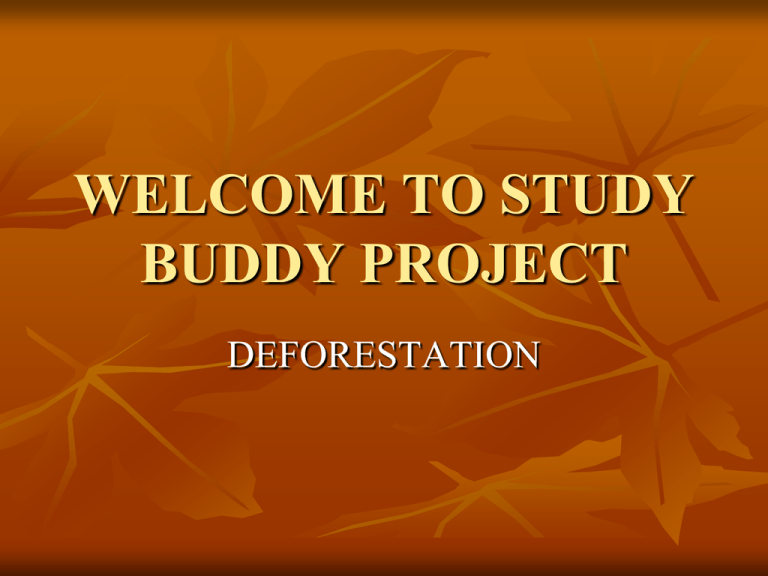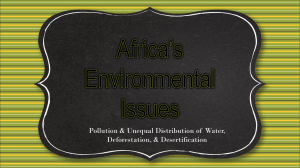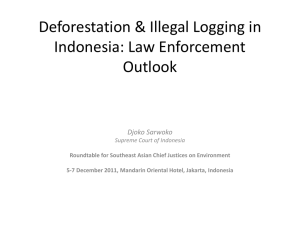the Study Buddy Deforestation Project
advertisement

WELCOME TO STUDY BUDDY PROJECT DEFORESTATION Discription on deforestation Deforestation is the clearance of naturally occurring forests by logging and burning. Deforestation occurs for many reasons: trees or derived charcoal are used as, or sold, for fuel or as a commodity, while cleared land is used as pasture for livestock, plantations of commodities, and settlements. The removal of trees without sufficient reforestation has resulted in damage to habitat, biodiversity loss and aridity. These pictures are showing the destruction of plants in certain areas Environmental problems due to deforestation Atmospheric problems Deforestation is ongoing and is shaping climate and geography. Deforestation is a contributor to global warming and is often cited as one of the major causes of the enhanced greenhouse effect. The incineration and burning of forest plants to clear land releases large amounts of CO2, which contributes to global warming. Both the decay and burning of wood releases much of this stored carbon back to the atmosphere. Trees and other plants remove carbon (in the form of carbon dioxide) from the atmosphere during the process of photosynthesis and release oxygen back into the atmosphere during normal respiration. Only when actively growing can a tree or forest remove carbon over an annual or longer timeframe Hydrological problems The water cycle is also affected by deforestation. Trees extract groundwater through their roots and release it into the atmosphere. When part of a forest is removed, the trees no longer evaporate away this water, resulting in a much drier climate. Deforestation reduces the content of water in the soil and groundwater as well as atmospheric moisture. Deforestation reduces soil cohesion, so that erosion, flooding and landslides ensue. quicker transport of surface water can translate into flash flooding and more localized floods than would occur with the forest cover. Trees, and plants in general, affect the water cycle significantly: their canopies intercept a proportion of precipitation, which is then evaporated back to the atmosphere (canopy interception); their litter, stems and trunks slow down surface runoff; their roots create macropores - large conduits - in the soil that increase infiltration of water; they contribute to terrestrial evaporation and reduce soil moisture via transpiration; their litter and other organic residue change soil properties that affect the capacity of soil to store water. their leaves control the humidity of the atmosphere by transpiring, 99% of the water absorbed by the roots moves up to the leaves and is transpired. Soil problems Undisturbed forest has very low rates of soil loss, approximately 2 metric tons per square kilometer (6 short tons per square mile). Deforestation generally increases rates of soil erosion, by increasing the amount of runoff and reducing the protection of the soil from tree litter. This can be an advantage in excessively leached tropical rain forest soils. Tree roots bind soil together, and if the soil is sufficiently shallow they act to keep the soil in place by also binding with underlying bedrock. However most deforestation only affects the trunks of trees, allowing for the roots to stay rooted, negating the landslide. Ecological problems Deforestation results in declines in biodiversity The removal or destruction of areas of forest cover has resulted in a degraded environment with reduced biodiversity. Forests support biodiversity, providing habitat for wildlife; moreover, forests foster medicinal conservation. Since the tropical rainforests are the most diverse ecosystems on Earth and about 80% of the world's known biodiversity could be found in tropical rainforests, removal or destruction of significant areas of forest cover has resulted in a degraded environment with reduced biodiversity. Scientific understanding of the process of extinction is insufficient to accurately make predictions about the impact of deforestation on biodiversity. Species-area models are known to overpredict the number of species known to be threatened in areas where actual deforestation is ongoing, and greatly overpredict the number of threatened species that are widespread. It has been estimated that we are losing 137 plant, animal and insect species every single day due to rainforest deforestation, which equates to 50,000 species a year. Others state that tropical rainforest deforestation is contributing to the ongoing Holocene mass extinction. The known extinction rates from deforestation rates are very low, approximately 1 species per year from mammals and birds which extrapolates to approximately 23,000 species per year for all species. Predictions have been made that more than 40% of the animal and plant species in Southeast Asia could be wiped out in the 21st century . Such predictions were called into question by 1995 data that show that within regions of Southeast Asia much of the original forest has been converted to monospecific plantations, but that potentially endangered species are few and tree flora remains widespread and stable . Since the tropical rainforests are the most diverse ecosystems on Earth. Economic impact Damage to forests and other aspects of nature could halve living standards for the world's poor and reduce global GDP by about 7% by 2050, a major report concluded at the Convention on Biological Diversity (CBD) meeting in Bonn. In developing countries almost three billion people rely on wood for heating and cooking. Historically utilization of forest products, including timber and fuel wood, have played a key role in human societies, comparable to the roles of water and cultivable land. Today, developed countries continue to utilize timber for building houses, and wood pulp for paper. The forest products industry is a large part of the economy in both developed and developing countries. Short-term economic gains made by conversion of forest to agriculture, or overexploitation of wood products, typically leads to loss of long-term income and long term biological productivity (hence reduction in nature's services). West Africa, Madagascar, Southeast Asia and many other regions have experienced lower revenue because of declining timber harvests. Illegal logging causes billions of dollars of losses to national economies annually. According to a study, "in most areas studied, the various ventures that prompted deforestation rarely generated more than US$5 for every ton of carbon they released and frequently returned far less than US$1". The price on the European market for an offset tied to a one-ton reduction in carbon is 23 euro (about US$35). Historical causes Prehistory Small scale deforestation was practiced by some societies for tens of thousands of years before the beginnings of civilization. The first evidence of deforestation appears in the Mesolithic period. It was probably used to convert closed forests into more open ecosystems favourable to game animals. With the advent of agriculture, larger areas began to be deforested, and fire became the prime tool to clear land for crops. In Europe there is little solid evidence before 7000 BC. Mesolithic foragers used fire to create openings for red deer and wild boar. In Great Britain, shade-tolerant species such as oak and ash are replaced in the pollen record by hazels, brambles, grasses and nettles. Widespread decrease in elm pollen across Europe between 8400-8300 BC and 7200-7000 BC, starting in southern Europe and gradually moving north to Great Britain, may represent land clearing by fire at the onset of Neolithic agriculture. The Neolithic period saw extensive deforestation for farming land . Stone axes were being made from about 3000 BC not just from flint, but from a wide variety of hard rocks from across Britain and North America as well. They include the noted Langdale axe industry in the English Lake District, quarries developed at Penmaenmawr in North Wales and numerous other locations. Evidence of deforestation has been found in Minoan Crete; for example the environs of the Palace of Knossos were severely deforested in the Bronze Age. This picture shows An array of Neolithic artifacts, including bracelets, axe heads, chisels, and polishing tools. Area difference of virgin forest in America in years 1850 and today.. Controlling deforestation Reducing Emissions from Deforestation and Forest Degradation Major international organizations, including the United Nations and the World Bank, have begun to develop programs aimed at curbing deforestation. The blanket term Reducing Emissions from Deforestation and Forest Degradation (REDD) describes these sorts of programs, which use direct monetary or other incentives to encourage developing countries to limit and/or roll back deforestation. Accord was reached with a collective commitment by developed countries for new and additional resources, including forestry and investments through international institutions, that will approach USD 30 billion for the period 2010 – 2012. Methodological guidance for forest monitoring was emphasized. Reforestation In many parts of the world, especially in East Asian countries, reforestation and afforestation are increasing the area of forested lands. The amount of woodland has increased in 22 of the world's 50 most forested nations. Asia as a whole gained 1 million hectares of forest between 2000 and 2005 . Summary Therefore we should plant a new crop if we are going to cut another tree. We should have a habit of planting more and more trees and look after them very well. If you grow more plants you can reduce soil erosion increase of CO2. Not only that if you grow more trees you can live a happy and pleasant life. THANK YOU FOR YOUR KIND ATTENTION!!! THIS PROJECT WAS DONE BY: Name:M. ILHAM HASSANALI - 9F e-mail:hassanali.ilham96@gmail.com Name:M. INSHAAF ANVER - 9F e-mail:ultimatebilla2008@gmail.com STUDDY BUDDIES OF ROYAL COLLEGE








